EcoSchools in your Classroom
EcoSchools activities, connected to the Ontario curriculum (more regions coming soon)Teamwork & Leadership
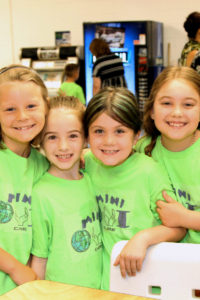
Science & Technology
Overall Expectation: 3.4
The Ontario EcoSchools program is designed to engage students of all ages in environmental campaigns and initiatives. Students in younger grades can participate as members of the EcoTeam and can contribute to school-wide activities as a class.
St. Patrick Catholic School (HPCDSB) has an EcoTeam made up of students from Kindergarten to Grade 2. These environmental leaders organize events, share announcements, and monitor their school’s progress.
Helpful Resources: EcoTeam Messaging
Claim this in your Online Application – Certification Question(s): 1.3, 1.5
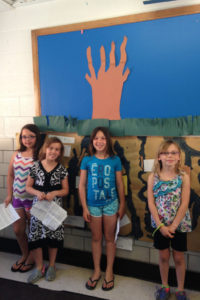
Language
Oral Communication
Overall Expectation: 2
Offer your students the opportunity to build leadership and communication skills. In class, have students create songs, announcements, and presentations about important environmental topics to share with your school through classroom presentations, PA announcements, and school assemblies.
At WRDSB’s Sandhills Public School grade five students created an EcoRap to perform to the school. “Nurture Nature every day, drinking water is one way / We can use the refill station, and that will stop us wastin’! / Plastic bottles, Plastic bottles, just say, “No!” / Plastic bottles, plastic bottles, let them go!
Helpful Resources: Eco Assemblies
Claim this in your Online Application – Certification Question(s): 1.5, 1.7
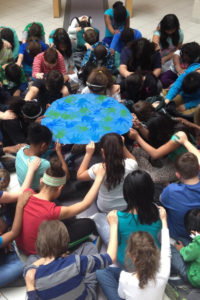
The Arts
Dance
Overall Expectation: A1
Students can take a lead in engaging the whole school in social justice and environmental action. One effective way to bring attention these important issues is for students to use dance as a language to communicate messages and ideas.
The EcoTeam at Pauline Johnson CVS (GEDSB) were very keen to raise awareness about the severity and scale of the environmental crises facing young people today. To do this they choreographed and performed a dance piece as part of their annual eco-assembly in the fall.
Claim this in your Online Application – Certification Question(s): 1.5

Civics & Citizenship
Civic Engagement & Action
Overall Expectation: C3
Provide an opportunity for student-led inquiry projects that analyse environmental civic issues and develop plans of action to implement positive change. As a class or in groups, students can examine different perspectives and courses of action. Students can then display their issues and plans of action on a school environmental bulletin or website.
At Mitchell District Secondary School (AMDSB), students researched a variety of water issues and the stakeholders involved. They then created a number of video displays that outlined the issues from different perspectives.
Helpful Resources: Environmental Activist Bulletin Board
Claim this in your Online Application – Certification Question(s): 1.6
Send us your own EcoSchools In Your Classroom connections and we’ll share it with the entire EcoSchools community.
Email us at programs [at] ecoschools.ca for more information.
Energy Conservation

Science & Technology
Energy In Our Lives
Overall Expectations (2): 1, 2
Creating engaging posters, announcements, and presentations can help to convey messages about responsible energy use. Through the development and delivery of these communication strategies and campaigns, students explore various ways to conserve energy and investigate the different types of energy that are used at school.
Students from Lakeview Public School (DSBN) created a Golden Light Switch Award that helps to encourage the whole school community to conserve energy. The award is presented to the classroom that consistently turns off their lights when not required.
Helpful Resources: Switch Off, Computer Monitor Monsters
Claim this in your Online Application – Certification Question(s): 2.11

Science & Technology
Conservation of Energy and Resources
Overall Expectation(s): 1, 3
In grade five, there is a unique opportunity to complete the entire Energy Conservation section when studying the Science and Technology unit: Conservation of Energy and Resources. By monitoring energy practices within the school and using Ontario EocSchools worksheets, there are many opportunities for inquiry-based learning.
At Holy Spirit (YCDSB) students conducted the Classroom Lighting Assessment for each class in the school. Then, students created a display in a common area showcasing how many trees each classroom would need to plant in order to offset their energy usage.
Helpful Resources: Walkabout Worksheet, School Energy Consumption Assessment, Classroom Lighting Assessment, Appliance Audit
Claim this in your Online Application – Certification Question(s): 2.1, 2.2, 2.3, 2.5, 2.6, 2.7, 2.8, 2.9, 2.10, 2.11, 2.12

Language
Media Literacy
Overall Expectation: 3
Offer your students the opportunity to build their communication skills by developing and delivering a communication campaign around the topic of Energy Conservation. Students can use a variety of communication tools such as posters, movies, websites, or newsletters and deliver them in class, during PA announcements or at school assemblies.
A student at Dunbarton SS (DDSB) used the data from an energy audit of school lighting to deliver a campaign to reduce energy consumption. He created posters outlining the benefits of turning lights off when not in use.
Helpful Resources: Switch Off Campaign
Claim this in your Online Application – Certification Question(s): 2.11

Environmental Sciences
Conservation of Energy
Overall Expectation: F2
Student monitoring systems can provide authentic primary source data to help understand energy conservation practices. Engage students in conducting an energy audit of your school’s energy use to further develop their understanding of the impacts of energy use, identify areas of improvement, and propose ways to improve energy efficiency.
Students in the Dunbarton Secondary School (DDSB) EcoTeam conducted an energy audit of the school hallway lights. Using this information they campaigned to have half the hallway lights shut off in areas where there was sufficient natural light. The EcoTeam also created posters outlining why the lights were off and what the benefits of that would be.
Helpful Resources: Classroom Lighting Assessment, School Energy Consumption Assessment, and School Appliance Audit
Claim this in your Online Application – Certification Question(s): 2.12
Send us your own EcoSchools In Your Classroom connections and we’ll share it with the entire EcoSchools community.
Email us at programs [at] ecoschools.ca for more information.
Waste Minimization
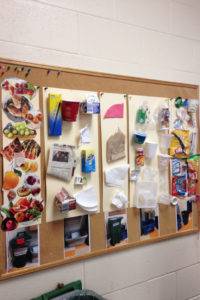
Science & Technology
Understanding Structures & Mechanisms
Overall Expectation: 1
Conducting a visual waste audit can be an illuminating experience for students and staff. Younger grades can partner with older grades to carry out an audit of garbage, recycling, and organics (if applicable) generated during an average school day.
Divine Infant Catholic School (OCSB) takes steps after their annual waste audit to ensure that the whole school community sees their findings. Students develop presentations and displays to encourage ongoing waste minimization.
Helpful Resources: Show off your waste audit, Share what goes where, Waste Audit Instructions (partner with Grade 4 or 5 students)
Claim this in your Online Application – Certification Question(s): 3.12

Mathematics
Data Management & Probability
Overall Expectation(s): 1, 2
Monitoring waste systems and waste generation at your school can provide authentic primary data, which can then be displayed in graphs, charts, and tables.
Students at Alexander Kushka (NCDSB) conducted an in-depth waste audit. Based on the results, students generated comprehensive graphs about their school’s waste generation and then provided recommendations to reduce and divert waste at school.
Helpful Resources: Walkabout Worksheet, School Waste Audit
Claim this in your Online Application – Certification Question(s): 3.10, 3.12
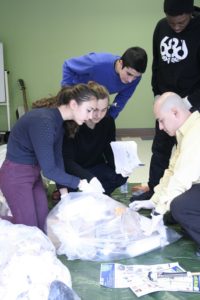
Science & Technology
Interactions in the Environment
Overall Expectation: 1
Provide an opportunity for student-led inquiry projects that assess the impacts of school waste management practices and technologies on the environment and develop a school-wide campaign as a way of mitigating these impacts.
Students at St. Pio de Pietrelcina (DPCDSB) launched waste campaign which encourages better waste practices. The EcoTeam checked for waste contamination in classrooms on a monthly basis. School with the most contamination were given “Scooter the Skunk” to remind them to do better next time. Awards were also given to classes with the least contamination.
Helpful Resources: Target Contamination Campaign
Claim this in your Online Application – Certification Question(s): 3.11
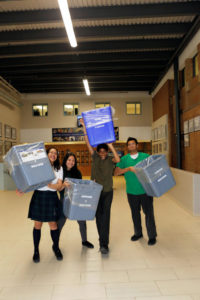
Environmental Sciences
Reducing & Managing Waste
Overall Expectation: E2
Conducting a waste audit can help identify key waste issues within your school. Use the audit to determine the effectiveness of various waste management practices and then propose a plan of action for waste reduction based on your findings.
Students at Saugeen District Secondary School (BWDSB) completed a comprehensive waste audit. They were then able to break down the data from the audit into pie charts and create posters with graphs to communicate areas that required improvement throughout the school.
Helpful Resources: School Waste Audit
Claim this in your Online Application – Certification Question(s): 3.12
Send us your own EcoSchools In Your Classroom connections and we’ll share it with the entire EcoSchools community.
Email us at programs [at] ecoschools.ca for more information.
School Ground Greening
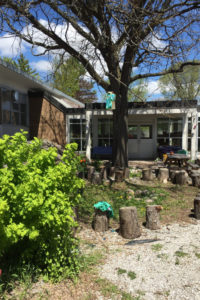
Science & Technology
Growth & Change in Plants
Overall Expectation(s): 1, 2, 3
Ongoing care of school ground greening projects ensures that outdoor spaces remain healthy and vibrant for years to come. Students can explore ways in which they can have a positive impact on plants that grow on their school grounds.
The school ground greening project at Sunningdale Public School (HDSB) has been a long-term initiative supported by the whole school community. It offers habitat for wildlife and provides numerous opportunities for students, teachers, and the community to enjoy and learn in the outdoors.
Helpful Resources: Mulch is Magic: Factsheet
Claim this in your Online Application – Certification Question(s): 4.1b
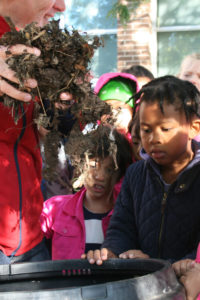
Science & Technology
Habitats & Communities
Overall Expectation(s): 1, 2
Creating a School Ground Greening project with your class can provide a multitude of opportunities to investigate the interdependence between plants and animals within specific habitats. Establish a no-mow zone, nature-study area, or habitat garden and discover the unique relationship between plants and animals.
Students at Sir Wiliam Osler (SCDSB) use their no mow zone and butterfly garden for learning. The space is used to investigate the relationship between plants and insects, as well as observe and collect data.
Helpful Resources: Ready, Set, Get Outside, Nature Study Area
Claim this in your Online Application – Certification Question(s): 4.1a, 4.1b, 4.3, 4.5

Science & Technology
Interactions in the Environment
Overall Expectation(s): 2, 3
Creating a School Ground Greening project with your class can provide a multitude of opportunities for learning in, about and for the environment. Establish a no-mow zone, nature-study area or habitat garden and discover the unique relationships between biotic and abiotic components of an ecosystem.
School Ground Greening projects can also be a place to learn about Indigenous perspectives on sustainability.
Students at St. Thomas Aquinas CSS (DPCDSB) consulted with a local Indigenous Elder to help plan and implement an Indigenous medicine/herb garden. The garden is shaped like a turtle and includes 41 native species. The garden is used as a centre of learning for multiple classes.
Helpful Resources: Nature Study Area
Claim this in your Online Application –
Certification Question(s): 4.1, 4.4

Biology
Sustainable Ecosystems & Human Activity
Overall Expectation: B1
In grade 9 science, students can assess the effectiveness of greening their school grounds and explain why the initiative is important to the sustainability of the ecosystem. Students can determine how the project improves biodiversity and ecological sustainability. They may then propose additional actions that can be implemented in the future.
Catholic Central High School (LDCSB) has a School Ground Greening project entitled The Diversity of Native Plants Project, which includes two prairie gardens and one woodland garden. Only native plants are planted, all of which are self-sustaining, including Smooth Aster, Joe Pye Weed, Milk Weed, Big Blue Stem, and Indian Grass. Their project is used as a teaching space and all plants are labeled, and the area is used as an arboretum and living herbarium.
Helpful Resources: Biodiversity Factsheet
Claim this in your Online Application – Certification Question(s): 4.3
Send us your own EcoSchools In Your Classroom connections and we’ll share it with the entire EcoSchools community.
Email us at programs [at] ecoschools.ca for more information.
Curriculum

Provide your students with hands-on learning activities to engage them in learning about the environment.
- All FDK to Grade 3 Lesson Plans
- All Grade 4 to 6 Lesson Plans
- All Grade 7-8 Lesson Plans
- All Grade 9-12 Lesson Plans
Claim this in your Online Application – Certification Question(s): 5.1 – 5.7
Send us your own EcoSchools In Your Classroom connections and we’ll share it with the entire EcoSchools community.
Email us at programs [at] ecoschools.ca for more information.
Environmental Stewardship

Social Studies
Local Community
Overall Expectation: B1
Students at Southwood Public School (GECDSB) kicked-off their school ground clean-up by learning about the impacts of plastic bags. They hosted an assembly that focused on the environmental dangers of plastic bags, particularly how plastic can impact wildlife habitat. Staff and students tracked the number of plastic bags that were collected during the clean-up and used this data to encourage the community to choose reusable bags instead of plastic.
Helpful Resources: School Ground Greening Clean Up – Campaign Kit, School Ground Greening Clean Up – Campaign Planner
Claim this in your Online Application – Certification Question(s): 6.1 – 6.4

Social Studies
Canada’s Interactions with the Global Community
Overall Expectation(s): B1, B2
The Great lakes is a fantastic topic to explore the importance of international cooperation and to investigate the unique political, social, economic, and environmental importance of this resource. As a culminating task, have students create a whole- school action and awareness campaign focused on the Great Lakes. Discuss the importance of water stewardship and become acquainted with your local waterways.
Students at James McQueen (UGDSB) conducted a Stream of Dreams campaign, during which students learned about the importance of keeping their local waterways healthy
Helpful Resources: The Great Lakes
Claim this in your Online Application – Certification Question(s): 6.1 – 6.4

Science & Technology
Water Systems
Overall Expectation: 8
A powerful way to engage students in environmental stewardship is by running a school-wide campaign to assess and reduce the impact of human activities on water resources. For example, students can learn about the wide range of impacts of plastic water bottles on the environment then campaign to reduce water bottle usage at the school.
At St. Isidore (OCSB) the EcoTeam set up a blind tap vs bottled water taste test for the whole school as part of their push to go bottle-free. In the end, students preferred the taste of tap water!
Helpful Resource: Water Awareness and Action
Claim this in your Online Application – Certification Question(s): 6.1 – 6.4
 Social Sciences & Humanities
Social Sciences & Humanities
The Food Consumer
Overall Expectation: D2
Students in grade 12 can explore the benefits of choosing local foods. Through a school-wide campaign, complex issues such as responsible consumerism, can be unpacked and used as the context for environmental learning and action. Students can engage the broader school community with such initiatives as promoting The Great Big Crunch, hosting a local food potluck, or coordinating a farmer’s market day.
Paris District High School (GEDSB), chose to engage the whole school community in a week of environmental actions in October. They kicked off this initative with campaigns that were linked to local food issues and climate change. Meatless Monday encouraged staff and students to reduce their ecological footprint by choosing plant-based foods and, Tasty Tuesday promoted recipes that featured delicious local and organic ingredients.
Helpful Resources: Local Food
Claim this in your Online Application – Certification Question(s): 6.1 – 6.4
Send us your own EcoSchools In Your Classroom connections and we’ll share it with the entire EcoSchools community.
Email us at programs [at] ecoschools.ca for more information.
